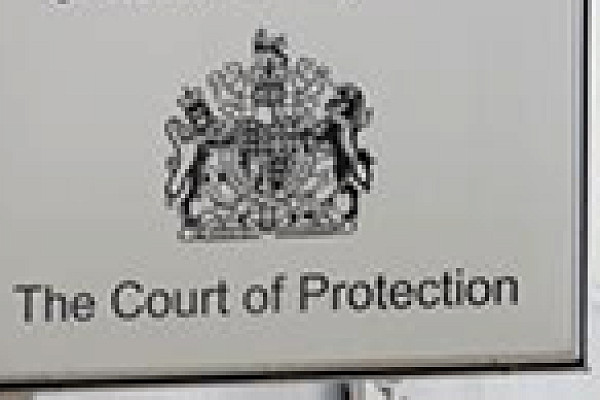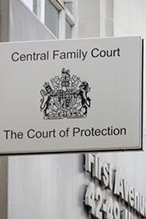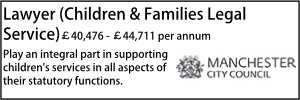

The final say
News
Must read
Families refusing access to support
Features Test

Producing robust capacity assessments and the approaches to assessing capacity

Disability discrimination and proportionality in housing management

Cross-border deprivation of liberty

Dealing with unexplained deaths and inquests

Court of Protection case update: May 2025
Features

Producing robust capacity assessments and the approaches to assessing capacity

Disability discrimination and proportionality in housing management

Cross-border deprivation of liberty

Dealing with unexplained deaths and inquests

Court of Protection case update: May 2025
Sponsored articles
What is the role of the National Trading Standards Estate & Letting Agency Team in assisting enforcement authorities?
Webinars
Is Omeprazole the new EDS?
More features
Provision of same-sex intimate care
Court of Protection case update: April 2025
High Court guidance on Article 3 engagement in care at home cases
‘Stitch’, capacity and complexity
Issuing proceedings in best interests cases
Court of Protection case law update: March 2025
The Health and Social Care (Wales) Bill Series – Regulation and Inspection of Social Care
The Health and Social Care (Wales) Bill Series – Direct Payments for NHS Continuing Healthcare
What is the right approach to Care Act assessments?
Disabled people in immigration bail: the duties of the Home Office and local authorities
Capacity, insight and professional cultures
Court of Protection update: February 2025
Setting care home fees
Could this be the end for local authority-provided residential care?
“On a DoLS”
It’s all about the care plan
Court of Protection case update: January 2025
Mental capacity and expert evidence
Best interests, wishes and feelings
Capacity, sexual relations and public protection – another go-round before the Court of Appeal
Court of Protection Update - December 2024
Fluctuating capacity, the “longitudinal approach” and practical dilemmas
Capacity and civil proceedings
Recovering adult social care charges via insolvency administration orders
Court of Protection case update: October 2024
Communication with protected parties in legal proceedings
The way forward for CQC – something old, something new….
The Ombudsman, DoLS and triaging – asking the impossible?
Outsourcing and the Human Rights Act 1998 – the consequences
Commissioning care and support in Wales: new code of practice
London Councils says grants budget "still stands" despite JR blow
- Details
London Councils has insisted that the proposed budget for its grants scheme for 2011/12 “still stands” even though a High Court ruling this week means the group will have to re-run the consultation process over its planned cuts.
A London Councils spokeswoman said: “Following the result of the judicial review, the London Councils grants budget agreed by London borough leaders in December still stands.
“The judge found against the claimants on most of their grounds of challenge but has asked us to do further work on equalities in the context of the agreed budget. We are in the process of assessing the best way of taking this forward.”
Mr Justice Calvert-Smith declared that a decision by the leaders’ committee of London Councils on 14 December 2010 adopting a categorisation of currently commissioned services and deciding on the timing of proposed changes and transitional arrangements in respect of the scheme was unlawful.
London Councils had reached its decision without due regard to its statutory equalities duties under the Race Relations Act 1976, the Sex Discrimination Act 1976 and the Disability Discrimination Act 1995, the judge said.
The group was ordered to undertake a lawful process of reconsideration, in accordance with these public sector equality duties and – if it comes into force during the reconsideration process – the replacement public sector equality duty under s.149 of the Equality Act 2010.
Louise Whitfield, associate solicitor at Pierce Glynn, solicitors to the claimants, said the judge’s ruling meant that the whole process must be re-run.
“London Councils has to re-think the whole thing and once that is concluded, give anyone who is losing their funding three months’ notice from that point,” she added.
The grants scheme’s budget for 2011/12, put forward by the leaders’ committee and approved by over two-thirds of boroughs, was set at £17.8m, down from £26m. The budget is also likely to fall substantially further for 2012/13.
London Councils is understood to be urgently analysing the time and cost of the extra work it will now have to undertake following the High Court ruling. The group hopes to fund this work as far as possible through the scheme’s 2010/11 and 2011/12 budgets as well as reserves.
Philip Hoult
High Court quashes London Councils plan to cut £10m from grants scheme
- Details
A High Court judge has today quashed a decision by London Councils to cut £10m from its £26.4m grants scheme to voluntary organisations in the capital.
Mr Justice Calvert-Smith ruled that the group’s consultation process was flawed and that they had not met their statutory equality duties. He ordered the group to re-run its consultation process with full equality impact assessments.
The judicial review proceedings were brought by service users of two of the organisations affected by London Councils’ proposed cuts.
Louise Whitfield, a solicitor at law firm Pierce Glynn who acted for the claimants, said: “This case establishes that even in the current economic climate, it remains of paramount importance that public sector funding cut decisions are properly assessed for their gender, disability and race equality impacts. If they are not, public sector funding cut decisions will be unlawful.”
Whitfield said London Councils’ proposed cuts would have affected more than 200 voluntary and community sector organisations in London, and tens of thousands of Londoners.
A spokesman for London Councils said the group would not be commenting until the judicial review hearing comes to a conclusion, which is expected to be on Tuesday 1 February.
Philip Hoult
Kent care home consultation process referred to Audit Commission by scrutiny committee
- Details
The consultation process that preceded a care home closure programme by Kent County Council is to be investigated by the Audit Commission after being referred by the council's scrutiny commission.
The chairman of the council's cabinet scrutiny committee, Trudy Dean, said that she had concerns over the way that alternative proposals put forward by opponents of the plans were assessed by the council and the lack of financial information provided to members ahead of the decision.
Mrs Dean, a Liberal Democrat councillor, told local paper News Shopper: “I’m concerned by the lack of information members had regarding finances behind the proposal, and the lack of information given to people who were consulted. It leads me to consider whether the consultation was wholly honest.”
She said that the panel which evaluated alternative proposals put forward during the consultation process consisted entirely of adult social services staff, meaning that counter-proposals were “very unlikely” to be successful. “It would have been very difficult for them to assess it independently as they all have a personal interest because they were involved with the original plans,” she said.
Kent County Council said it was confident its 19-week consultation had been well-run and that it would co-operate with the Audit Commission.
High Court to hear London Councils grant scheme JR this week
- Details
A High Court hearing into the decision by the London Councils group to cut its £26.4m grants scheme by as much as 80% is to take place this Thursday.
The claimants – service users of two of the organisations affected, the Roma Support Group and the nia project – are being advised by law firm Pierce Glynn on the judicial review proceedings.
They have previously argued that the process involved in cutting the budget was “unfair” and the timetable “so tight that they had no option to involve the High Court”.
There were also concerns that London Councils had failed to consider equality issues carefully.
In November the claimants’ solicitor Louise Whitfield said: “The grants scheme was specifically set up to provide London-wide services to the most vulnerable groups that would not or could not be provided by individual boroughs.
"The services used by my clients are educational support for Roma children and a specialist refuge for women fleeing domestic violence with funding for both projects meant to continue to 2012. However, London Councils have made a preliminary assessment that these services are ‘local’ and indicated that their funding may be cut as early as March 2011.”
The two organisations would face “extraordinary difficulty” in securing alternative sources in the three months’ notice given by London Councils of the potential cut in funding, she added.
Release date
- Details
Can release from hospital be a deprivation of liberty? Matthew Flinn examines an important ruling in the Upper Tribunal.
In Secretary of State for Justice v RB [2010] UKUT 454, the Upper Tribunal has departed from a line of court authority to decide that where a patient has been detained under the Mental Health Act 1983, conditionally discharging that patient from hospital subject to conditions which might themselves amount to a form of detention is compatible with Article 5 of the European Convention of Human Rights, the right to liberty .
RB, who was aged 75, had been detained under the Mental Health Act on 30 June 1999 following a conviction for indecent assault on a boy aged under 16. He suffered from a persistent delusional disorder, which rendered him a “strongly misogynistic”, lifelong paedophile.
Following a failed application for discharge from hospital in 2007, on 24 April 2009 the Mental Health Review Tribunal decided that under sections 72 and 73 of the Act, RB could be discharged subject to conditions, including a condition that he reside at a specified care home, and that he did not leave the grounds of that care home except when supervised. If he breached any of these conditions he could be recalled to hospital. RB was keen for the discharge to occur and willing to comply with those conditions.
The Secretary of State sought to oppose the release of RB, and appealed this decision to the Upper Tribunal.
The unusual aspect of the appeal was that the Secretary of State relied in part on Article 5 of the European Convention on Human Rights, which enshrines the right to liberty and freedom from arbitrary detention. He argued that according to authority, a discharge to a care home as ordered in the case of RB, having regard to the conditions imposed upon him, amounted to a continuing deprivation of liberty, and was contrary to Art 5 and ultra vires (outside of his powers).
The upshot of this argument was that the discharge order was unlawful, and RB should have remained detained in hospital. It appears that the Secretary of State was motivated by the view that if a patient is not sufficiently safe to be discharged without restrictive conditions placed upon his movement, he should not be released at all.
The authority relied on by the government included a Court of Appeal decision (R (Secretary of State for the Home Department) v Mental Health Review Tribunal [2002] EWCA Civ 1868 – “the PH case”) and three High Court decisions (R (G) v Mental Health Review Tribunal [2004] EWHC 2193 (Admin), R v Secretary of State for the Home Department) v Mental Health Review Tribunal [2004] EWHC 2194 (Admin) and IT v Secretary of State for the Home Department [2008] EWHC 1707).
The Secretary of State argued that these cases bound the Upper Tribunal to apply the “PH principle”, which provided that the concept of “discharge” under section 73 of the Mental Health Act entailed a release from actual detention, so that when a conditional discharge had such stringent conditions attached that it did not constitute a release from detention, it was unlawful.
The Upper Tribunal declined to follow this line of authority. It said that it was not bound by the Court of Appeal decision in the PH case, since that case had not definitively decided that a discharge required a release from detention (that principle had been addressed in the court below; the CA had simply proceeded on the basis that it was correct). It also said that it was not bound by the more forthright High Court authorities because, pursuant to changes made by the the Tribunals, Courts and Enforcement Act 2007, it was exercising a jurisdiction equivalent to what the High Court had exercised in the past – it was therefore dealing with decisions of a court of co-ordinate jurisdiction, and was not bound to follow its decisions if it considered them to be wrong.
On the substantive issue before it, the view of the Upper Tribunal itself was that the word “discharge” did not necessarily entail a release from detention to a state of liberty. It preferred what it considered to be a more natural approach to the word; it noted that dictionary definitions showed that, depending on context, the word could mean “release from custody”, but could also mean release in the more general sense of “dismiss” or “send away”:
“Thus, in ordinary language, a patient may be ‘discharged’ from hospital, without any connotation that he is being released from the deprivation of liberty in the legal sense. In relation to section 72, it seems more natural to read the word ‘discharge’ as meaning simply release from the state there mentioned, that is from ‘detention in a hospital for treatment’.”
This resulted in a much narrower PH principle: a tribunal could not conditionally discharge a person with conditions that amount to detention in a hospital for treatment. Continuing detention in some other environment, however (or presumably a shift to another hospital under conditions which did not amount to detention), would not be ultra vires or a breach of Article 5.
In reaching this decision, the Upper Tribunal appeared perturbed by the invocation of Article 5 as a means of requiring the continued hospital detention of a patient, rather than facilitating his discharge. In paragraph 52 of its judgment it said: “We agree respectfully…that it is ‘curious’ to find the Secretary of State praying in aid Article 5 of the ECHR to deny the patient a conditional discharge. We note the similar comments of Dr. McKenna, from his ‘perspective as a clinician’, as to the use of the ‘unusual lever’ of cases on human rights to restrict the liberty of a man who ‘has capacity and who consents (enthusiastically) to the proposed transfer’.”
It is perhaps this unease which motivated its reasoning, and its clear desire to avoid following case law which, even if not binding, was to have strong persuasive value. It might be asked why, when the dictionary offers “release from custody” as one of the natural meanings of “discharge”, this was not the most natural interpretation to choose in context.
After all, RB’s detention did amount to a form of custody, and as the Upper Tribunal itself noted, the powers of the Mental Health Review Tribunal to order discharge under sections 72 and 73 of the Mental Health Act 1983 were enacted as a direct result of the Strasbourg decision in X v United Kingdom (1981) 4 EHRR 188, which held in relation to Article 5(4) that compulsorily detained patients were entitled to periodic review of their detention by a court with power to direct, rather than simply to recommend, discharge. They were thus enacted to ensure that a prisoner could challenge their detention; discharge was perceived as a means of securing liberty.
On the other hand, it might be argued that if the government is concerned that dangerous patients are being inappropriately released, the proper means of addressing that issue is a change in the criteria upon which discharge may be ordered, rather than the counter-intuitive invocation of a right to liberty.
Further, as the Upper Tribunal pointed out: “The premise for exercise of the tribunal’s powers is that the patient has previously been lawfully detained (so that Article 5 has been complied with); but that he does not now need to be detained in a hospital and that some other form of accommodation is appropriate, subject to the possibility of recall. The next step is to devise the conditions. At that stage, it is hard to see why the question of whether the conditions would amount to detention for the purposes of Article 5 should come into it. Even if they do amount to such detention, there will be no breach of article 5 because the 1983 Act makes provision for the procedural safeguards guaranteed by Article 5.”
It concluded that “[t]he tribunal’s concern [when considering to discharge a patient] should be simply to decide what is necessary for the well-being and protection of the patient, and the protection of the public and to satisfy themselves that the patient is wiling to comply with the conditions and to that extent consents to them”. A tribunal should not have to preoccupy itself with fine distinctions involved in the question of whether or not the conditions it deems necessary would amount to a deprivation of liberty, undermining its own power to act in the first place.
Matthew Flinn is a barrister at 1 Crown Office Row (www.1cor.com). For more articles on human rights, go to the set’s dedicated human rights blog. http://ukhumanrightsblog.com/
1 Crown Office Row’s Robert Kellar appeared for the Secretary of State for Justice in this case.
Forcing the issue
- Details
A key part of the government’s strategy to combat forced marriages, preventing people under the age of 21 from entering the country to marry, has been heavily criticised by the Court of Appeal. Adam Wagner examines the ruling.
The decision in Quila & Ors v Secretary of State for the Home Department & Ors [2010] EWCA Civ 1482 shows that even policies which pursue a legitimate and laudable aim must still be a proportionate to the problem they seek to address, or risk breaching the human rights of those affected. But it also highlights how difficult it is to set effective policies to combat hazardous arrangements which can involve rape, child abuse and domestic violence, and affect thousands of UK residents annually.
Lord Justice Sedley said that the ban on immigration for the purposes of marriage for people under 21 is an “arbitrary and disruptive impact of the rule on the lives of a large number of innocent young people”.
Paragraph 277 of the Immigration Rules prevents anyone under the age of 21 from entering the country as a spouse, unless there are clear exceptional compassionate circumstances to merit the Home Secretary granting an exception.
The rationale of the policy, as stated by the government counsel in this appeal, is that forced marriages can often involve rape, child abuse and domestic violence. The problem is not only serious but also large: according to one report there may have been between 5,000 and 8,000 reported cases in the UK in 2008.
Unfortunately, forced marriages often go unreported, so it is difficult for the government to identify victims. It is known, however, that a significant proportion (just over a quarter) involve those aged 18-20. Therefore, by raising the age limit below which people cannot immigrate to marry, forced marriages would be significantly reduced. Moreover, the older the individual, the better equipped they are to deal resist pressure to enter the marriage in the first place. So the remaining cases may be easier to deal with through other means.
But a blanket ban such as this clearly runs the risk of breaching the human rights of 18 to 21 year olds who cannot emigrate to marry. Specifically, the right to private and family life (article 8 of the European Convention) and the right to marry (article 12). As such, as is the case with any breaches of “qualified” human rights – that is, rights which can be lawfully breached by the state in certain limited circumstances – the policies must be proportionate to the ends sought.
Three-pronged attack
The two couples who brought the original (initially unsuccessful) claim criticised this rationale on the basis that there was no alternative report, and that some government statistics indicate that in 2007 no more than 4% of marriages of 18 to 20 year olds were considered by the Forced Marriage Unit to be forced marriages.
They attacked the rule on three levels. First that it is irrational due to its harmful and unnecessary consequences. Secondly, it a disproportionate inhibition on family and private life and on the right to marry, both under common and human rights law. Thirdly, it is discriminatory, making an illogical exception in favour of service personnel.
On irrationality, Lord Justice Sedley said that the rule “has little, but not nothing, to do with preventing forced marriages”. As such, although the policy was very contestable, it was not irrational. His ruling is no great surprise: irrationality is very difficult to prove in public law cases, as a court must be convinced that a policy is so outrageous that no sensible person could have arrived at it.
On the second ground of challenge, proportionality, the appellants had more success. Lord Justice Sedley held that rule 277 represents a “direct interference with what the common law and Convention both value as a fundamental right”, as "in the eyes of the common law it is not simply the right to marry and not simply the right to respect for family life but their combined effect which constitutes the material right: that is to say a right not merely to go through a ceremony of marriage but to make a reality of it by living together. For the state to make exile for one of the spouses the price of exercising the right to marry and embark on family life requires powerful justification..."
Having found that the rules interfered with fundamental rights, the next question – as is often the question in cases involving human rights – was whether the interference was proportionate.
It was not. The rule “subjects all young couples to an unspoken but irrebuttable presumption that their marriage is a forced one.” The judge had some sympathy (para 53) with the government’s point that the rule had to be a blanket one as it is was practically impossible to enquire into the voluntariness or otherwise of a marriage. But this explanation was not enough.
Moreover, the justification for the policy, as advanced by the Home Office, “”is only obliquely, partially and in large part speculatively related to the measure under scrutiny”. In other words, it was built on shaky ground, and the reasoning on the human rights implications was “both inadequate and muddled” (para 62).
As to discrimination, Lord Justice Sedley declined to rule on this, as the arguments had already been addressed by his ruling under proportionality. The point was raised due to the exception introduced by amendment in favour of members of the armed services, who are excluded from the ban. Again, the judge was unimpressed by the government’s justification for this, as there was no evidence that members of the armed services were more or less likely to be affected by forced marriages.
Lord Justices Pitchford and Gross agreed with Lord Justice Sedley, although for slightly different reasons (see para 68 onwards).
Success, but rule not struck down
Despite Lord Justice Sedley’s strong criticism of rule 277, he declined to go further than ruling that the particular effect on the two appellants was unlawful. He did not strike down the rule, since the court had “not been dealing with its impact on couples where neither spouse is a United Kingdom national”.
So, whether to keep the rule in a limited form, or to drop it altogether, is a matter for the Home Secretary, who may also choose to appeal the decision to the Supreme Court. Given the strong criticism of the policy’s rationale by the court, it seems likely that it will be reassessed altogether, or run the risk of more potentially expensive claims.
Meanwhile, although the decision shows that all public policy must be legitimate to the end sought or run risk of breaching human rights law, it also demonstrates the difficulty of setting policies which prevent forced marriages. The government has already been criticised by the High Court for attempting to use secret evidence procedures to combat the issue. But, if these shady and potentially abusive arrangements remain unreported, it is difficult to see how the government can attack the problem without affecting more people than is strictly necessary.
Adam Wagner is a barrister at 1 Crown Office Row (www.1cor.com). This article first appeared on the chambers’ UK Human Rights Blog.
Angus McCullough QC (who has had no part in this article), and Neil Sheldon of 1COR were instructed by the Treasury Solicitor in the Quila case.
Page 255 of 270
Locums
Case Law Update

The final say
In association with...

Poll
in association with...

Events

Directory































